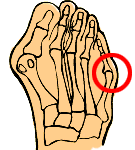Tailor’s Bunion
What are Tailor’s Bunion?
The terms doctors use to describe a bunion that forms by the little toe are Tailor’s Bunion and Bunionette. This type of bunion is similar to the bunion that forms by the big toe joint, except it forms on the joint just below the fifth toe. It is called a Tailor’s Bunion because years ago tailors would sit on the floor with their legs crossed and sew for hours. This constant and abnormal pressure on the fifth toe, and the bone below it (the fifth metatarsal head) would cause an inflamed and painful bump to form that resembled bunions that formed on the big toe side of the foot. |
|
A Tailor’s Bunion is a complex deformity that involves the following foot pathology:
-
A bump that develops on the outer side of the foot, in the area where the little toe and the bone it connects to (the fifth metatarsal) meet. The joint where these two bones meet is called the fifth metatarsophalangeal joint.
-
The turning inward of the little toe, so that it presses against the fourth toe (the little toe is no longer straight).
Tailor’s Bunions are a progressive deformity, and if left untreated the bump will become larger, and the little toe will eventually lie over or underneath the fourth toe.
- Causes
-
The normal foot is made up of bones and joints that are held tightly together, in a precise relationship. In order for a Tailor’s Bunion to form, the ligaments and tendons that hold the bones and joints together must be more flexible (lax) than normal. This abnormal laxity allows the fifth metatarsal to gradually drift towards the outside of the foot, and the little toe to turn in, toward the fourth toe. The result is a prominent bump on the outside of the fifth metatarsal, at the metatarsophalangeal joint. If pressure is applied to this bump (like pressure from a shoe), the bump and its surrounding soft tissues enlarge, causing pain, swelling, and eventually a Tailor’s Bunion.A Tailors type deformity can also be a simple bump on the dorsal lateral side of the fifth metatarsal head and associated soft tissue. This type is very localized and is generally caused by shoe pressure or pressure from other outside sources.
The most common causes of lax (flexible) foot ligaments are:
-
The genes we inherit from our parents
-
Flat feet
-
The weakening of muscles and ligaments caused by advancing age
-
Injury.
Tailor’s Bunion progression may be hastened by:
-
Wearing high heel and pointed toe shoes. These types of shoes apply abnormal pressure to the little toe and force it over toward the fourth toe; and, irritate the fifth metatarsal head causing a bump to form (when bone is irritated it enlarges).
-
Injury to the outer side of the foot, or little toe may damage the fifth metatarsalphalangeal joint, and speed up Tailor’s Bunion formation.
-
Arthritis of the fifth metatarsalphalangeal joint may cause the joint to become enlarged, and a bunion may then form.
-
One leg being shorter than the other. When walking, the foot on the short leg turns in and down, trying to “reach” the ground. The foot is trying to equalize the length of the legs. This action of the foot turns the fifth metatarsal head into the shoe, allowing the shoe to rub against the fifth metatarsal head with excessive force. This will cause swelling, inflammation, pain, and growth of the Tailor’s Bunion.
- Treatment
-
Long-term treatment must be directed towards reducing abnormal pressure on the fifth metatarsal head. Re-balancing the foot, and allowing the foot to function as if it was not abnormally flexible best accomplish this. One of the best ways to accomplish this is custom-made orthotics. Our custom-made orthotics will:
-
Gently control and reduce flexibility of the foot. This allows the foot to function normally.
-
Protect the fifth metatarsal head from excessive pressure, by the use of our unique lateral wedge, which correctly supports the fifth metatarsal and reduces excessive pressure on the metatarsal head (the Tailor’s Bunion).
-
Compensate for a short leg with the addition of lifts, to equalize the length of the legs.
-
This will allow the feet to function normally. As a result, the deformity should not worsen, and the pain should gradually subside. If the foot is not re-balanced, the deformity and pain will become worse. In addition, comfort is also provided to the arch, shins, knees, and lower back by the use of modern materials. These unique materials provide semi-flexible support to the arch by absorbing the shock of each step, rather than our foot absorbing the shock. When your weight is removed from the orthotic, the arch returns to its original height since the material we use has a built-in “memory.”
Short-term pain relievers include the following:
-
Wear wider and flatter shoes, with a rounded toe.
-
Apply skin emollients to the bunion, before putting your shoes on. This may help to reduce friction on the skin overlying the bunion, which may help to reduce your pain.
-
Gentle massage with a topical pain reliever can help to provide comfort. By combining the pain relieving properties of Corganics Relief Topical Analgesic Cream with gentle massage, pain, swelling, and inflammation can be reduced or eliminated.
-
Exercise the toe. With your hand, move the toe up and down, and gently move it out as far as is comfortable, for 3 to 5 minutes daily. If this becomes painful, stop immediately.
-
If you ever experience open sores, extreme redness, or extreme pain, see a podiatrist immediately. If the problem persists consideration should be given to surgical correction of the deformity.
